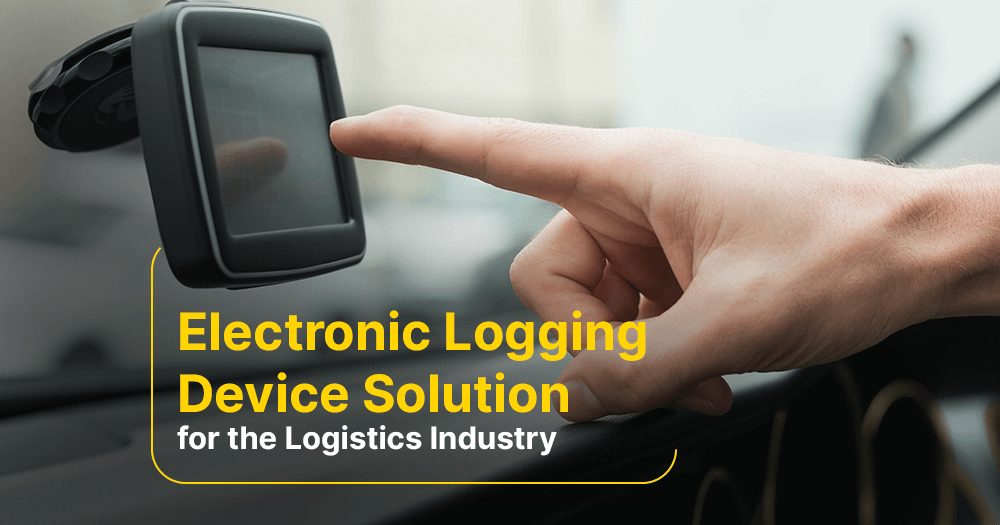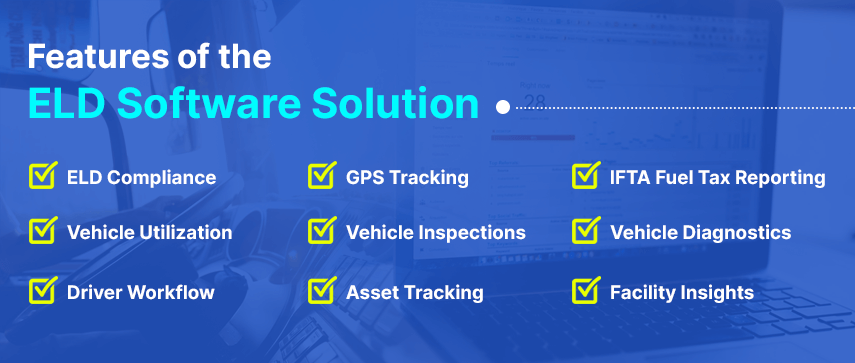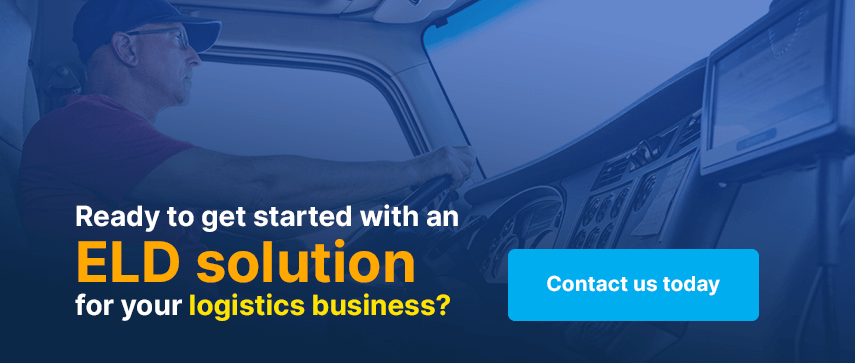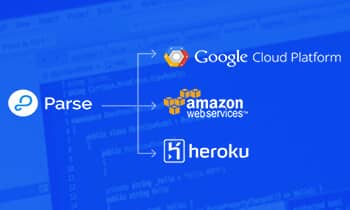Back in the day, a truck driver had to do much paperwork along with driving. Truckers had to manage paper logbooks to record their daily activity, including shift hours, break times, driven miles, fuel consumption, and more. Not only was this process counterproductive and tedious, but it was also prone to human errors. And these mistakes invited high CSA scores and penalties.

In 2017-2018, FMCSA ruled out the ELD mandate that obliged commercial motor vehicles (CMVs) to have certified electronic logging devices (ELDs). But besides being compliant with HOS and RODS rules, electronic logbooks for truck drivers offer numerous benefits like streamlined operations and reduced costs.
So, let’s understand the concept first – what is an ELD solution, why is it so crucial for trucking companies, and how can you develop one for your business?
What is an ELD?
An electronic logging device (ELD or e-log) is an electronic machine attached to the engine of a commercial motor vehicle to record driving hours. Unlike the hours of service (HOS) in the United States and as Drivers’ working hours in Europe, different guidelines regulate the driving hours of commercial drivers. An ELD monitors a vehicle’s engine to track and capture data regarding whether the engine is running, the vehicle is moving, driven miles, and the like.
Back in the day, trucking companies used paper logs or electronic onboard recorders (EOBR) to track service hours. However, despite being accurate in terms of data, the EOBR-style log lacked a consistent data format and required regeneration on an equivalent paper format for examination and utilization. Electronic logbooks for truck drivers resolve this problem by providing real-time, accurate, and enforceable hours-of-service data.
Why is an ELD Essential for Your Trucking Business?
The Federal Motor Carrier Safety Administration (FMCSA) mandates to record all driving hours using an ELD. But besides compliance, ELDs can be conducive to your trucking business in the following ways:
Reduced administrative burden
ELDs automatically track and record vehicles’ movement, eliminating manual paperwork and administrative onus. With ELDs, you don’t need to bother about manually logging hours of service. You can, therefore, save time, cost, and efforts you would have otherwise spent doing administrative work.
Minimized fuel wastage
You can track how much fuel your drivers are utilizing, and how much they’re exhausting. ELDs allow you to ascertain how much time a driver spends idling, which can reduce fuel wastage.
Vehicle maintenance
Electronic logbook app connects to the diagnostic port of the vehicle, which enables active monitoring of the fault codes. Thus, you can always stay updated with your vehicle maintenance issues and take precautionary measures at the right time.
Location tracking and route management
Taking unnecessarily longer routes can add to your losses. With ELDs, you can monitor your drivers and vehicles using GPS tracking. In addition to real-time location tracking, ELD also aids you in contriving better routes, minimizing distractions, and maximizing productivity.
Identification of bad driving behaviors
Bad driving behaviors can increase fuel consumption, operational costs, and risk of compliance issues. An ELD compliant fleet management solution allows you to track and identify bad behaviors and use the data to make the desired improvements.
Reduced liabilities
Road accidents are not always the driver’s fault, but trucking companies have to deal with lawsuits every now and then. In cases when your driver isn’t at fault, the data from ELD can be used as evidence to strengthen your case.
-
Increased safety
According to FMCSA, ELDs help save 26 lives and prevent 562 injuries every year. Additionally, ELDs entail GPS features that alleviate the risk of a stolen or hijacked vehicle.
Lower insurance premium
Trucks and fleets with ELDs get better insurance premiums. Since ELDs increase fleet safety, insurance companies offer better rates than fleets without ELDs.
Enhanced profits
Last, electronic logbooks for truck drivers reduce administrative burden, operational costs, and liabilities, thereby helping you with higher profits.

All About ELD Compliance
ELD compliance, also known as the electronic logging device mandate or ELD mandate, is an attempt by the FMCSA to minimize road accidents and improve road safety in the USA. According to the mandate, vehicles will be put out of service for not having compliant electronic logging devices. The mandate is in effect since December 2017 for most commercial vehicles, and more than 80% of the large fleets have installed compliant ELDs.
ELD Rule
As per the FMCSA mandate, the ELD rule:
- Obligates the use of ELD by commercial drivers who are required to prepare records of duty status (RODS) and hours-of-service (HOS)
- Specifies the standards of ELD design and performance, and requires ELDs to be registered with the FMCSA
- Determines the necessary supporting documents truckers and drivers need to carry
- Forbids the persecution of drivers, and provides aid to drivers who feel they’ve been harassed
Hours of Service (HOS) Rules
- 11-hour driving rule: A driver is required to take a 10-hour break after 11 hours of driving time.
- 14-hour on-duty shift rule: A driver must take a 10-hour break after a 14-hour shift. The 14 hours include the total driving time, along with the Off Duty and Sleeper Berth hours.
- 70-hour in 8 days rule/ 60 in 7: The total Driving and On-Duty time for a driver cannot exceed 70 hours in an 8-day period. A variation of this rule also exists, limiting the total Driving or On-Duty to 60 hours in 7 days.
- 8-hour, 30-minute break rule: When a driver changes the status to On-Duty, he needs to take a 30-minute rest break in Off-Duty or Sleeper Berth. After the 30-minute break, the driver has a maximum of 8 hours before taking another 30-minute break.
- 10-hour break: After the expiry of an 11-hour or 14-hour clock, the driver must take at least 10 hours of consecutive break.
- 34-hour restart: In case a driver is low on time in his 70-hour clock, he can reset the 70-hour clock by taking 34 consecutive hours of Off-Duty or Sleeper Berth.
This rule has some exceptions as well, such as Yard Moves, Short Haul 100 / 150 Air Mile Exemption, and 8/2 Sleeper Split.
What does an ELD do?
Electronic logging devices are connected to a commercial motor vehicle engine to record vehicle activity and movements. Once installed and activated, the device automatically tracks and records the entire driving activity throughout the day. A typical ELD records the following information:
- Driver authentication with all details
- Vehicle mileage
- Driving time
- Location
- Engine hours
- Vehicle movements
- Ignition and power status
- Miles drove in each state and jurisdiction
- Date and time
So, How do Electronic Logbooks work?
Most modern ELDs are based in the cloud and utilize cloud computing to provide a stable, secure, and accurate data flow. A cloud-based ELD compliant fleet management solution comprises three essential elements, including:
- A vehicle tracking device, or a telematics device, connected to the vehicle
- An ELD software for fleet management
- A mobile app that runs on all devices and sends and receives ELD data
Which Trucking Businesses are Required to Comply with New ELD Regulations in 2018?
According to FMCSA, most of the motor carriers who are required to maintain RODS as per Part 395, 49 CFR 395.8(a) need to comply with the new ELD regulations. The regulations are also applicable to commercial buses and trucks within the USA and to Mexico- and Canada-domiciled drivers.
Who will be exempted from complying with the 2018 ELD mandate?
The new ELD rule has no expectations; however, there are some driver and vehicle exemptions. Let’s quickly discuss who is exempt from the ELD rule, according to FMCSA.
Driver exemptions:
- Who uses the timecard exemption
- Who are required to keep RODs no more than eight days in 30 days
- Who use paper RODs for no more than eight days in 30 days
- Who conduct driveaway-towaway operations, in which the driven vehicle is the delivery, motor home, or a recreational vehicle
- Who drive vehicles manufactured before 2000
Vehicle exemptions:
- Vehicles manufactured before 2000, or those with engines with documents or plates predating the model year 2000 or before
Caveat: Mobile homes, modular home transporters, and vehicles belonging outside the USA are not an exemption.
ELD Software Solution for Trucking Business
An electronic logging device software solution consists of an ELD appliance (AOBRD, telematics devices) connected to the engine control module, fleet management software for the dispatcher, and a truck driver logbook app for the driver.
When the ELD device connects to the vehicle’s engine via a diagnostic port, it starts recording driving and engine-on hours of the vehicle. The device transmits this data to the software application, which processes the data received and converts it to editable logs.
Drivers can then access these logs to evaluate their shift hours. The dispatcher can also access driver logs to audit performance and behavior by connecting the ELD device to a fleet management software system.
Importance of ELD Software Solution
Before the FMCSA mandate and the widespread use of ELD applications, truck drivers relied on traditional logbooks to update the required data. These logbooks included a time grid on each page, which divided the 25-hour day into 15-minute segments.
This type of logging didn’t provide accurate information as it had no direct link with the truck’s engine. The driver was required to manually enter HOS information, which was not only time-consuming but also prone to error.
ELD compliant fleet management solution is an entirely editable electronic log that acts as a replacement for paper logs. The software is compliant with FMCSA/USDOT rule 395.8 regarding a commercial driver’s hours of service and record duty of status. The app works in combination with the ELD device to automatically record driving time and movements.
Integrated ELD solution is a nexus of ELD hardware connected to the engine, logbook app, and fleet management system. It can record accurate hours and driver’s compliance with HOS and RODS requirements more effectively.
Let’s discuss why using an electronic logbook app is absolutely critical for trucking companies.
Provides peace of mind: Compliance issues are one of the biggest hurdles trucking companies may encounter, which can lead to hefty fines and insurance-related hurdles. Using an integrated ELD solution with a fleet management system and mobile app, you can access accurate HOS and RODS information. This helps you stay compliant and have some peace of mind.
Accurate hours-of-service: Another compliance-related issue that can cost you a bit is recording exact driver HOS. When recording work hours manually, the chances are the driver may lose track of time and how much is remaining in his shift and cycle. Using an integrated ELD software solution, the drivers can access an intuitive hours-of-service clock that shows them exactly the time left in shifts and the status of about 60 or 70-hour cycles.
Enhances overall productivity: Drivers no longer need to glance at the clock repeatedly to track their working and break hours. They need to log in to the mobile app and start driving. The ELD device does the recording and transmits the data to the electronic logbooks for truck drivers and fleet management systems. This smooth workflow helps drivers avoid violations and penalties, thus, leading to improved productivity.
In-depth working of the ELD system
In modern vehicles, the area under the hood entails a full-featured electronic system that connects with various sensors to measure speed, location, acceleration, driving time, engine-on time, and the like. This automated system consists of Electronic Function Units (ECU), small micro-processing modules that control functions like engine, transmission, braking, fuel consumption, and more.
Modern-day vehicles comprise around 70 ECUs, which communicate with each other using protocols like Controller Area Network (CAN). The protocols facilitate the uninterrupted flow of data within ECUs and sensors. To ensure data security, these ECUs don’t have a consolidated hub to prevent unauthorized access to sensitive driver information.
However, modern vehicles have an On-Board Diagnostic (OBD) port, a hardware surface located beside the steering wheel, which allows physical scan devices to access and monitor data regarding vehicle and engine movements. An electronic logging device (ELD) is a physical scanning device connected to the OBD-II (updated OBD) port to access vehicle information. ELDs come with an “engine-connected logging” toggle, which the driver needs to enable. The driver can then wirelessly connect an electronic logbook app to the device to obtain real-time electronic logbooks with the following data:
- Engine hours
- Driven miles
- Road speed
- Date and time
Features of the ELD Software Solution

The salient features of an ELD software solution are centered on ELD mandate and vehicle operations, such as ELD compliance, GPS tracking, shift hours, fuel tracking, and more. Let’s take a look at the key features of an ELD software solution.
- ELD Compliance: ELD solutions are registered with the FMCSA and built for the ELD mandate requirements. These systems keep your CSA scores in check and provide alerts for HOS violations to ensure you stay compliant no matter where you go.
- GPS Tracking: These solutions feature real-time GPS tracking. You can use real-time monitoring to know the location of your drivers. The GPS functionality also helps in eliminating guesswork and guiding the drivers on the optimal routes.
- IFTA Fuel Tax Reporting: The automated IFTA Fuel Tax Reporting eliminates the need for manually collecting fuel receipts and state mileage. It automates complex calculations of fuel purchases and distance traveled in different jurisdictions. This results in improved operational efficiency and a reduced risk of audit and human error.
- Vehicle Utilization: Ineffectual fuel consumption is one of the leading causes of increased trucking costs. An ELD compliant fleet management solution offers in-depth vehicle utilization information for tracking real-time fuel consumption and idling. Thus, it helps with massive cost savings and allows you to discover utilization trends.
- Vehicle Inspections: Ensuring vehicle safety is one of the vital responsibilities of fleet managers. The vehicle inspection feature offers custom inspection forms, real-time alerts, and inspection history to ensure you stay on top of your fleet status.
- Vehicle Diagnostics: Vehicle issues can lead to hefty losses. Electronic logbooks for truck drivers offer vehicle diagnostics feature that enables you to catch vehicle maintenance issues. The automatic monitoring and instant alerts help you discover maintenance issues early and stay ahead of vehicle health and repairs.
- Driver Workflow: Managing dispatch operations can be challenging. ELD solutions facilitate instant communication and efficient dispatch to simplify driver workflow.
- Asset Tracking: Real-time GPS functionality allows you to get location-based insights, track your most valuable assets, and make informed decisions. It helps you enhance dispatcher efficiency, prevent theft, and reduce detention time. The asset tracking feature also allows you to track performance against delivery schedules and identify misuse.
- Facility Insights: Advanced truck logbook apps offer facility insights to streamline your scheduling with in-depth warehouse information. It enables you to mobilize your fleet and make smart load decisions to minimize truck wait times and improve efficiency.
Benefits of Using ELD Software Solution
Using an electronic logging device for commercial vehicles is mandatory. It’s not unusual for truckers to be on the defensive and resist using a machine recording their activity. But drivers don’t have a choice here due to the HOS compliance constraints. However, an ELD solution offers benefits that are beyond compliance. These include:
1 More miles on the road
Before electronic logbooks became popular, truck drivers spent over 20 hours a year filling out paper driver logs. Electronic logbooks for truck drivers reduce the time taken for HOS paperwork by 15 minutes a day, along with another five to ten hours a week, by rounding to the nearest minute for stops. By eliminating the waste of time, you can increase drivable hours, which leads to more money.
2 Faster inspections
ELD logbooks are easy and quick to inspect. The results are precise for an officer to evaluate, so the truck drivers can pass the inspections quickly and get back on the road faster. Drivers and inspectors no longer need to delve into paper logs to find HOS violations or errors.
3 Reduced burdensome paperwork
Let’s face it. Truck drivers don’t choose to embrace the road because they love filling out paperwork. ELDs cut down paperwork by automating the HOS compliance process. All the drivers need to do is log into the Mobile HOS Electronic Logbook App and start driving.
4 Eliminate form and manner errors
Do you know what defines humans? Mistakes. Nobody’s perfect, but errors in driver logs, like recording the wrong time or entering the wrong location can add up and lead to increased CSA scores and fines. ELDs automate HOS logs, IFTA fuel tax reporting, and DVIRs, thereby eliminating the risk of manual logging errors.
5 Real-time warnings
Electronic logbooks for truck drivers provide push notification alerts when the driver approaches time-sensitive events, to help them remain HOS compliant. This eliminates the risk of drivers earning a violation for a missed 30-minute break or running out of 11 hours of a driving day.
6 Driver safety in case of an accident
In the case of road accidents, ELDs can document driver safety. ELDs accurately capture vehicle activity and driver behavior before, during, and after an accident. This information can be handy evidence and be useful in defending drivers against lawsuits.
7 Seamless communication with the home office
Back in the day, check calls consumed a significant portion of the driver’s and dispatcher’s day. In fact, obtaining information as simple as the location or the driven hours required a series of phone calls. ELDs eliminate this hustle as dispatchers can use an ELD-compliant fleet management solution to get real-time information about the driver’s location and behavior.
How to Develop an ELD Compliant Electronic Logbook App and What Technical Capabilities Are Required?
As discussed, using an ELD compliant fleet management solution is not optional. If you wish to stay compliant with the FMCSA mandate, you’re obliged to use an electronic logging device and logbook software.
The question that emerges is whether you want to develop your own Mobile HOS Electronic Logbook App, get it outsourced, or purchase a firsthand ELD solution. All the options related to this solution have their pros and cons, but in this section, we’ll discuss a quick guide to developing an ELD compliant logbook app for truck drivers.
- HOS recording and alerting: The apparent reason why you have to use an ELD system in the first place is due to HOS compliance. Therefore, the primary feature of your ELD logbook app should be the recording of hours of service and duty status. A typical day of the truck driver comprises three statuses: On-Duty, Off-Duty, and Sleeper Berth. The mobile app should send notification alerts when a driver is about to enter HOS violations.
- Automatic IFTA and DVIR reporting: An ELD truck driver logbook app needs to record IFTA (fuel consumption and mileage) and DVIR (vehicle inspection). Besides, this information needs to be transmitted to the dispatcher in real-time.
- GPS positioning and mapping: A logbook app needs to have GPS functionality to help the driver get live traffic information, routing, fuel stations, service centers, and other road-related details. Also, make sure the dispatcher electronic logbook app also has access to GPS data to monitor driver behavior.
- Direct messaging: Drivers and dispatchers had to spend a significant amount of time on check calls, as discussed before. By integrating in-app direct messaging functionality between the driver and dispatcher, you can enhance instant, less time-consuming communication.
- Accident reconstruction: Commercial vehicles colliding and meeting with accidents is not a new story. But when an accident occurs, the dispatcher has to buy the driver’s version, regardless of what actually happened. By integrating an accident reconstruction feature, you can understand how the accident occurred and by whose mistake.
- Driver behavior monitoring: Unsafe driving behaviors can cause delays, excess idle times, and fuel wastage. The driving behavior monitoring feature enables you to get insights into driver behavior. You can use this data to make necessary changes or train your drivers.
Technical Capabilities
Your mobile HOS electronic logbook app needs to be equipped with cutting-edge technology to ensure superior performance. The technology used in the ELD software can vary depending on functionality, but there are a few vital technical capabilities every ELD app should possess. These include:
- HOS recording compliant with FMCSA guidelines
- GPS technology to provide real-time insights into driver’s location and route
- Accurate shift time clock to ensure HOS compliance
- Wi-Fi and Bluetooth connectivity for seamless reporting and communication
- Accurate, detailed generation of graphs that provide thorough analysis and inspection
- Support for all major platforms, such as Android and iOS
- Cloud capabilities for streamlined data storage, access, and retention
- UTC synchronization
- Simple plug-and-play installation
Final thoughts
Most trucking companies and fleet managers think of electronic logbooks for truck drivers as a solution to keep the FMCSA happy, and it’s valid to a certain extent. Without using a certified ELD system, your vehicle won’t be eligible to run on the roads. But ELD solutions are much more than just a compliance hack. They can help you increase productivity, maximize profits, reduce costs, and streamline operations. Yes, compliance with FMCSA’s ELD rule is critical, but that’s not the only reason you should be using electronic logging device solutions. If you haven’t already implemented an ELD system to your trucking business, do it now. Contact our team to develop a customized ELD solution for your trucking business.

Author's Bio

Nitin Lahoti is the Co-Founder and Director at Mobisoft Infotech. He has 15 years of experience in Design, Business Development and Startups. His expertise is in Product Ideation, UX/UI design, Startup consulting and mentoring. He prefers business readings and loves traveling.


